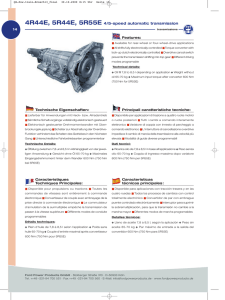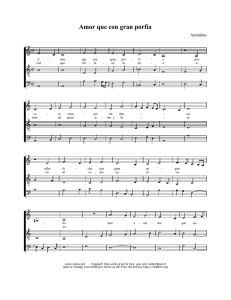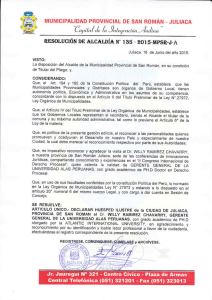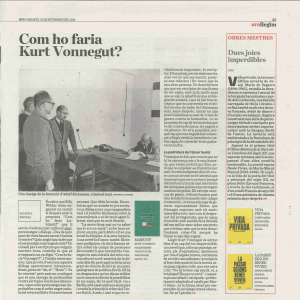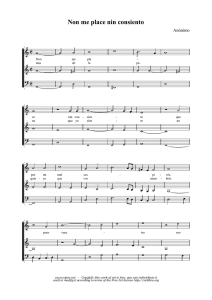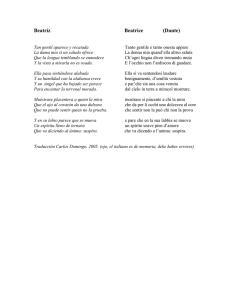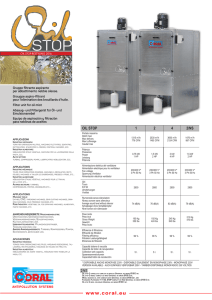schema di funzionamento
Anuncio
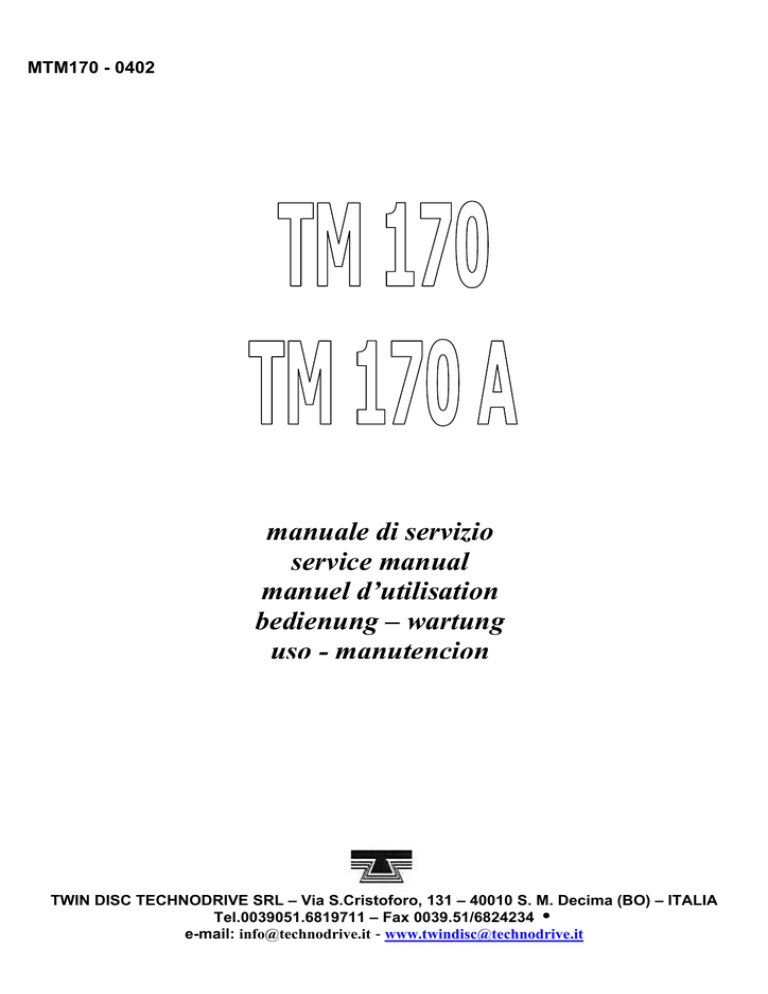
MTM170 - 0402 manuale di servizio service manual manuel d’utilisation bedienung – wartung uso - manutencion TWIN DISC TECHNODRIVE SRL – Via S.Cristoforo, 131 – 40010 S. M. Decima (BO) – ITALIA Tel.0039051.6819711 – Fax 0039.51/6824234 i e-mail: info@technodrive.it - www.twindisc@technodrive.it TM 170 – DIMENSIONI – DIMENSIONS – DIMENSIONS – ABMESSUNGEN - MEDIDAS A. – Indicatore di folle – Neutral indicator – Indicateur point mort – Leerlauf Anzeiger –Neutral indicador B. – Ritorno olio da scambiatore – Oil from cooler – Retour huile de l’échengeur – Ölrücklauf vom Kühler - Regreso del aceite del intercambiador (1/2” GAS) C. – Asta livello olio – Oil dipstick – Bouchon de niveau – Ölmeβstab – Varilla del nivel del aceite D. – Mandata olio allo scambiatore – Oil to cooler – Refoulement huile ou échangeur – Ölzulauf zum Kühler – Impulsion del aceite al intercambiador E. – Tappo scarico olio – Oil drain plug – Bouchon de vidange – Ölablaβdeckel – Tapòn de vaciado del aceite F. – Tappo carico olio – Filling plug – Bouchon de remplissange – Einfülldeckel Öl – Tapòn de llenado del aceite G. – Tappo du sfiato – Oil breather plug – Reniflard – Entüftungsdeckel – Tapòn de purga H. – Campana – Mounting flange – Cloche – Schwungradgehäuse – Campana: SAE 3, SAE 4 (x=12,5/33), BW (x=13,5) I. – Leva comando – Actuating lever – Levier de commande – Steuerhebel – Palanca de mando DIAGRAMMA DI POTENZA (DIPORTO) POWER CURVE (PLEASURE) DIAGRAMME DE PUISSANCE (PLAISANCE) LEISTUNGSKURVE (VERGNÜGUNGSBOOT) DIAGRAMA DE POTENCIA (RECREO) CARATTERISTICHE TECNICHE TECHNICAL DATA CARACTERISTIQUES TECNIQUES TECHNISCHE DATEN CARACTERISTICAS TÉCNICAS Rapporto-Ratio-RapportUntersetzung-Relacion Coppia max – Diporto Max torque – Pleasure Couple maxi – Plaisance Max Drehmoment-Vergnügungsboot Par max – Recreo Coppia max – Lavoro Max torque – Continuous Couple maxi – Continu Max Drehmoment- Arbeit Par max – Servicio Velocità max entrata Max input speed Vitesse maxi à l’entrée Max Eingangsgeschwindigkeit Velocidad màx a la entrada Peso a secco Weight without oil Poids sans huile Gewicht ohne öl Peso sin aceite 1,50 2,04 2,50 2,94 Nm 750 750 600 510 Nm 550 550 440 380 4000 RPM 75 Kg -2- TM 170A – DIMENSIONI – DIMENSIONS – DIMENSIONS – ABMESSUNGEN - MEDIDAS A. – Indicatore di folle – Neutral indicator – Indicateur point mort – Leerlauf Anzeiger –Neutral indicador B. – Ritorno olio da scambiatore – Oil from cooler – Retour huile de l’échengeur – Ölrücklauf vom Kühler - Regreso del aceite del intercambiador (1/2” GAS) C. – Asta livello olio – Oil dipstick – Bouchon de niveau – Ölmeβstab – Varilla del nivel del aceite D. – Mandata olio allo scambiatore – Oil to cooler – Refoulement huile ou échangeur – Ölzulauf zum Kühler – Impulsion del aceite al intercambiador E. – Tappo scarico olio – Oil drain plug – Bouchon de vidange – Ölablaβdeckel – Tapòn de vaciado del aceite F. – Tappo carico olio – Filling plug – Bouchon de remplissange – Einfülldeckel Öl – Tapòn de llenado del aceite G. – Tappo du sfiato – Oil breather plug – Reniflard – Entüftungsdeckel – Tapòn de purga H. – Campana – Mounting flange – Cloche – Schwungradgehäuse – Campana: SAE 3, SAE 4 (x=12,5/33), BW (x=13,5) I. – Leva comando – Actuating lever – Levier de commande – Steuerhebel – Palanca de mando DIAGRAMMA DI POTENZA (DIPORTO) POWER CURVE (PLEASURE) DIAGRAMME DE PUISSANCE (PLAISANCE) LEISTUNGSKURVE (VERGNÜGUNGSBOOT) DIAGRAMA DE POTENCIA (RECREO) CARATTERISTICHE TECNICHE TECHNICAL DATA CARACTERISTIQUES TECNIQUES TECHNISCHE DATEN CARACTERISTICAS TÉCNICAS Rapporto-Ratio-RapportUntersetzung-Relacion Coppia max – Diporto Max torque – Pleasure Couple maxi – Plaisance Max Drehmoment-Vergnügungsboot Par max – Recreo Coppia max – Lavoro leggero Max torque – Intermediate duty Couple maxi – Service leger comm. Max Drehmoment-Leichte Arbeit Par max – Servicio ligero Velocità max entrata Max input speed Vitesse maxi à l’entrée Max Eingangsgeschwindigkeit Velocidad màx a la entrada Peso a secco Weight without oil Poids sans huile Gewicht ohne öl Peso sin aceite 1.53 2.08 2.60 Nm 750 750 600 Nm 570 570 450 4000 RPM 75 Kg -3- SCHEMA DI FUNZIONAMENTO • • • • • La trasmissione del moto in marcia avanti avviene attraverso il gruppo frizione montato sull’albero di ingresso. Il senso di rotazione della flangia di uscita dell’invertitore, in marcia avanti, è contrario a quello del motore. In retromarcia la trasmissione del moto avviene attraverso il gruppo frizione montato sull’albero di rinvio. Le frizioni sono comandate dall’olio messo in pressione dalla pompa azionata dall’albero di rinvio e sono in grado di trasmettere la piena potenza sia in marcia avanti che in retromarcia. Il rapporto di riduzione è lo stesso in marcia avanti ed in retromarcia. INSTALLAZIONE • • • • • • L’invertitore TM170, TM170A può essere collegato unicamente a motori il cui senso di rotazione è antiorario (visto lato volano). Prima di effettuare il collegamento della flangia di uscita dell’invertitore all’asse elica, controllare che il disallineamento non superi il valore di 0,05 mm. Il cavo del comando a distanza deve essere collegato in modo tale da consentire la rotazione completa della leva di comando dell’invertitore dalla posizione di marcia avanti alla posizione di marcia indietro e garantire l’esatta posizione di folle. Dalla posizione di folle la marcia avanti si ottiene ruotando la leva di comando in senso antiorario. Il collegamento con lo scambiatore di calore va effettuato come in fig.1 L’invertitore viene fornito senza olio, prima della messa in funzione procedere al riempimento sino al massimo indicato sull’asta di livello quindi avviare il motore per consentire il riempimento delle tubazioni e verificare nuovamente il livello olio. Controllare che il cavo di comando si muova liberamente. Controllare che il cavo di comando sia in grado di fare compiere tutta la corsa alla leva dell’invertitore e che sia centrato sulla posizione di folle. USO • L’inserimento della marcia avanti, retromarcia e il passaggio in folle devono essere effettuati con il motore al minimo. L’invertitore viene fornito senza olio. Prima della messa in moto effettuare il riempimento sino al livello massimo indicato sull’asta. Prima di avviare il motore assicurarsi che l’invertitore sia in folle. Innestare la marcia con il motore non al minimo può causare danni all’invertitore o al giunto. MANUTENZIONE • • Controllare quotidianamente il livello olio. Effettuare il primo cambio olio dopo 50 ore di funzionamento; i successivi ogni 1000 ore di funzionamento (in ogni caso non oltre 12 mesi). • Ad ogni cambio olio effettuare la pulizia del filtro (rif.123). • Le frizioni non richiedono registrazioni. Operazioni di smontaggio e rimontaggio dell’invertitore o di sue parti devono essere fatte solamente da personale specializzato. LUBRIFICAZIONE • • • • Usare olio a specifiche API CD, SAE 20W40. La quantità di olio necessaria per l’invertitore completo di scambiatore di serie è 2,8 l. La temperatura massima dell’olio è di 105°C. La pressione olio alle frizioni, misurata a 1000 giri/minuto del motore con marcia inserita a temperatura olio di circa 60°C, deve essere compresa fra 20 e 22 bar. Gli attacchi per il manometro sono di M8x1 e sono posizionati, con riferimento alla fig.1, sulle prese A (marcia avanti) e C (marcia indietro). -4- OPERATING PROCEDURE • • • • • In forward speed motion is trasmitted by means of the clutch unit mounted on the input shaft. In forward speed, the rotating direction of the marine gear output flange is opposite to engine direction. In reverse speed, motion transmission is achieved by means of a clutch unit mounted on the intermediate shaft. Clutches are driven by the oil pressure raised by a pump controlled by the intermediate shaft and are able to trasmit full power both in forward and in reverse speed. The reduction ratio is the same in forward as well as in reverse speed. INSTALLATION • • TM170, TM170A marine gear can be connected to engine rotating counterclockwise (as seen from the flywheel side) only. Before connecting the marine gear output flange to the propeller axle, it is necessary to make sure that its misalignment does not exceed 0,05 mm. • The remote control must be connected so that the control lever can rotate completely from the forward speed position to the reverse speed position and a correct neutral position can be ensured. From the neutral position, forward speed is achieved by rotating the control lever counterclockwise. • The heat exchanger connection is achieved as shown in fig.1. • The marine gear is supplied without oil; therefore, before starting it, fill it up to the maximum level marked on the dipstick; then start the engine to allow the piping system to fill up and check the oil level again. Make sure that the control cable is easily movable. Make sure that the control cable is able to perform the complete lever stroke both in forward and in reverse and that it is well positioned in neutral. USE • The engagement of forward speed and reverse speed and the shifting to neutral position must be carried out while the engine is running at minimum speed. The gearbox is supplied without oil. Before the first start-up it must be filled up to the maximum level marked on the dipstick. Before to start the engine make sure that the gearbox is in neutral position. The gearbox should only be shifted with the engine at idle speed so as to avoid that the gearbox or the coupling may be damaged. MAINTENANCE • • • • Check oil level daily. Change the oil for the first time after 50 working hours: afterwards, replace the oil after 1000 working hours (or, at the longest, every 12 months). Whenever the oil is replaced, clean the filter (ref.123). Clutches require no adjustment. Disassembly and assembly of the gearbox or of its parts is to be made by specialized technicians only. LUBRICATION • • • • Use class CD (API service classification) oil SAE 20 W 40. Oil quantity for the marine gear with standard cooler: 2,8 l. Max oil temperature: 105°C. Oil pressure measured at 1000 RPM engine speed, oil temperature 60°C, is to be between 20 and 22 bar. Pressure gauge connections M8x1 are placed, refer to fig.1, on A (forward) and C (reverse). -5- 2 SCHEMA DE FONCTIONNEMENT • • • • • La transmission du mouvement en marche-avant se fait par l’intermédiaire du groupe d’embrayage monté sur l’arbre d’entrée. Le sens de rotation de la bride de sortie de l’inverseur, en marche-avant, est contraire à celui du moteur. En marche-arrière, la transmission du mouvement se fait par l’intermédiaire du groupe d’embrayage monté sur l’arbre de renvoi. Les embrayages sont commandés par huile mis sous pression par la pompe actionnée par l’arbre de renvoi et sont en mesure de transmettre toute la puissance aussi bien en marche-avant qu’en marche-arrière. Le rapport de réduction est le même en marche-avant et marche-arrière. INSTALLATION • Les inverseurs TM170-TM170A peuvent être reliés à des moteurs ayant un sens de rotation contraire à celui des aiguilles d’une montre (vu du côté volant). • Avant d’effectuer l’assemblage de la bride de sortie de l’inverseur à l’arbre d’hélice, contrôler que le desalignement ne dépasse pas la valeur de 0,05 mm. • La commande à distance éventuelle doit être connectée de façon à permettre la rotation complète du levier de commande de l’inverseur depuis la position de marche-avant à la position de marche-arrière et garantir la position exacte de point mort. A partir de la position de point mort, la marche-avant est obtenue en tournant le levier de commande dans le sens contraire à celui des aiguilles d’une montre. • Effectuer le raccordement de l’echangeur de chaleur comme indiqué à la fig.1. • L’inverseur est forni sans huile; avant la mise en service, remplir jusqu’au niveau maximum indiqué sur la jauge; démarrer ensuite le moteur pour permettre le remplissage des tubulures et vérifier de nouveau le niveau d’huile. Contrôler que le câble de commande se déplace librement. Contrôler que le câble de commande soit en mesure de faire toute la course du levier de l’inverseur et que le levier soit centré lorsqu’il est sur la position neutre. UTILISATION • La mise en marche-avant, marche-arrière et le passage au point mort doivent être effectués avec le moteur au rallenti. L’inverseur est fourni sans huile. Avant la première mise en service, effectuer le remplissage d’huile au niveau maximum indiqué sur la jauge. Avant la mise en route du moteur, assurez vous que l’inverseur est en position neutre. Embrayer l’inverseur au régime moteur minimum, sous peine de causer des dommages à l’inverseur, ainsi q’uà l’accouplement. ENTRETIEN • • • • Contrôler quotidiennement le niveau d’huile. Effectuer la première vidange d’huile aprés 50 heures de fonctionnement; ensuite toutes les 1000 heures de fonctionnement (dans tous les cas par plus de 12 mois). A chaque vidange effectuer le nettoyage du filtre (ref. 123). Les embrayages n’ont pas besoin de réglages. Les opérations de montage, de démontage de même que les interventions sur l’inverseur doivent être éffectuées par du personnel spécialisé. LUBRIFICATION • • • • Utiliser de l’huile, spécifications API CD, SAE 20 W 40. La quantité d’huile nécessaire pour l’inverseur avec refrigérant standard est 2,8 l. Température maxi de l’huile: 105°C. La pression de l’huile aux embrayages, avec le moteur à 1000 RPM et une température de l’huile de 60°C, doivent être comprises entre 20 et 22 bar. Les points de prise des manometres sont avec filetage M8x1 et sont placés, avec référence fig.1, sur A (marcheavant) et sur C (marche-arrière). -6- 3 FUNKTIONSWEISE • • • • Im Vorwärtsgang erfolgt die Übertragung von Bewegung und Drehmoment über die Schaltkupplung auf der Eingangswelle. Der Abtriebsflansch des Wendegetriebes dreht im Vorwärtsgang entgegengesetzt der Motordrehrichtung. Im Rückwärtsgang erfolgt die Übertragung von Bewegung und Drehmoment über die Schaltkupplong auf der Vorgelegewelle. Die Kupplungen werden durch den Öldruck, welcher durch die, von der Vorgelegewelle angetriebenen Pumpe, aufgebaut wird, gesteuert. Sie sind in der Lage, die volle Leistung sowohl im Vorwärts als auch im Rückwartsgang zu übertragen. INSTALLATION • • • • • • Das Wendegetriebe TM170-TM170A kann nur an Motoren angeschlossen werden, welche gegen den Uhrzeigersinn drehen (auf Motorschwungrad gesehen). Bevor der Abtriebsflansch an die Propellerwelle angeschlossen wird, muss sichergestellt werden, dass die Achsabweichung nicht mehr als 0,05 mm beträgt. Das Fernbedienungskabel muß so angeschlossen werden, daß die vollständige Bewegung des Schalthebels des Wendegetriebes von der Stellung “Vorwärtsgang„ in die Stellung “Rückwärtsgang„ ermöglicht und die genaue Leerlaufstellung gewährleistet wird. Von der Leerlaufstellung schaltet man in den Vorwärtsgang durch Drehen des Steuerhebels gegen den Uhrzeigersinn. Der Ölkühler wird gemäβ Abbildung 1 angeschlossen. Das Wendegetriebe wird ohne Öl geliefert. Vor der Inbetriebnahme bis zu dem auf dem Ölmeßtab angegebenen Höchststand befüllen, dann den Motor einschalten, damit die Leitungen gefüllt werden können, und den Ölstand erneut überprüfen. Bitte beachten Sie, daβ der Bedienzug sich leicht bewegen läβt. Bitte beachten Sie, daβ eine völlig freie Bewegung des Schalthebels gewährleistet ist von der Vorwärtsgangposition bis zur. BETRIEB • Das Einkuppeln von Vorwärtsgang, Rückwärtsgang und Leerlauf muß bei Leerlaufdrehzahl des Motors erfolgen. Das Getriebe wird ohne Öl geliefert; darum, bevor der Motor gestartet wird, füllem Sie das Getriebe bis zum Maximalstrich am Peilstab. Beachten Sie, daβ das Getriebe in Neutralposition steht, bevor Sie den Motor starten. Das Getriebe soll nur geschaltet werden, wenn der Motor im Leerlauf ist, um Kupplungschaden zu verhüten. WARTUNG • • • • Täglich den Ölstand kontrollieren. Nach 50 Betriebstunden den ersten Ölwechsel vornehmen. Die folgenden Ölwechsel nach jeweils 1000 Betriebstunden, aber mindestens alle 12 Monate, vornehmen. Bei jedem Ölwechsel den Filter (punkt 123) reinigen. Die Kupplungen brauchen nicht eingestellt zu werden. Demontage und Zusammenbau des Getriebes oder Getriebeteile darf nur durch spezialisierten Techniker ausgeführt werden. SCHMIERUNG • • • • Öl vom Typ API CD, SAE 20W40. Die erforderliche Ölmenge des Wendegetriebes, inklusive des serienmäßigen Kühlers, beträgt 2,8 Liter. Die Öltemperatur darf 105°C nicht überschreiten. Der Öldruck, gemessen bei 1000 u/min des Motors, bei eingelegtem Gang und einer Öltemperatur von ca. 60°C, muß zwischen 20 und 22 bar liegen. Die Manometeranschlüsse der Grosse M8x1 befinden sich an den Positionen “A„ (Vorwärtsgang) und “C„ (Rückwärtsgang). -7- ESQUEMA DE FUNCIONAMIENTO 4 • • • • • La transmisiòn del movimiento con la marcha avante tiene lugar a través del grupo de embrague montado en el eje de entrada. El sentido de rotaciòn de la brida de salida del inversor, con la marcha avante, es contrario al del motor. Con la marcha atrás, la transmisiòn del movimiento tiene lugar a través del grupo de embrague montado en el contraeje. Los embragues son accionados por el aceite puesto bajo presiòn por la bomba, que a su vez està accionada por el eje de reenvio, y pueden transmitir la potencia total tanto con la marcha avante como con la marcha atrás. La relacion de reduccion es la misma en marcha avante como en marcha atrás. INSTALACION • • • • • • El inversor TM170-TM170A se puede conectar ùnicamente a motores que tengan un sentido de rotaciòn contrario al de las agujas del reloj (visto desde el lado del volante). Antes de efectuar la conexiòn de la brida de salida del inversor al eje de la hélice hay que controlar que no haya una desalineaciòn superior a 0,05 mm. El cable del mando a distancia hay que conectarlo de tal manera que permita la rotaciòn completa de la palanca de mando del inversor desde la posiciòn de marcha avante hasta la posiciòn de marcha atràs, y que garantice la posiciòn exacta de punto muerto. Desde la posiciòn de punto muerto se obtiene la marcha avante girando la palanca de mando en el sentido contrario des las agujas del reloj. La conexiòn con el intercambiador de calor hay que efectuarla como indica la fig.1. El inversor se suministra sin aceite, por consiguiente antes de efectuar la puesta en funcionamiento hay que llenarlo hasta el màximo indicado en la varilla, luego poner en marcha el motor para que se llenen los tubos y por ùltimo verificar de nuevo el nivel de aceite. Controlar que el cable del telecomando se mueva libremente. Controlar que el cable del telecomando no tenga problemas para efectuar todo su recorrido y este bien centrado. USO • Hay que poner la marcha avante, la marcha atràs y el punto muerto con el motor al minimo. El inversor se suministra sin aceite antes de poner en marcha el motor, efectuar el llenado de aceite hasta el nivel maximo marcado en la varilla. Antes de arrancar el motor, asegurarse que el inversor esta en punto muerto. Insertar la marcha en el inversor sin estar el motor al ralenti puede causar daños al inversor o al acoplamiento elastico. MANTENIMIENTO • • • • Controlen diariamente el nivel de aceite. Cambien el aceite por primera vez después de 50 horas de funcionamiento; los siguientes cambios se haràn después de 1000 horas de funcionamiento (no dejen nunca pasar màs de 12 meses). Cada vez que se cambie el aceite hay que limpiar el filtro (ref.123). Los embragues no necesitan ajustes. Las operaciones de montaje y desmontaje del inversor solo pueden ser efectuadas por personal especializado. LUBRICACIÓN • • • • Usen aceite con caracterìsticas API CD, SAE 20W40. El inversor con intercambiador de serie necesita 2,8 litros de aceite. La temperatura màxima del aceite es de 105°C. La présion del aceite en los embragues, medida a 1000 revoluciones/minuto del motor con la marcha puesta y una temperatura del aceite de aproximadamente 60°C, tiene que estar comprendida entre 20 y 22 bares. Las conexiones para el manòmetro son de M8x1 y estàn colocadas segùn indica la fig.1, en las tomas A (marcha adelante) y C (marcha atràs). -8- 5 OIL Schema applicazione scambiatore – Attacchi manometri Exchanger application diagram – Pressure gauge connections H 2O H 2O Schema d’application de l’echangeur – Fixations des manometres A Prese per manometri: M8x1 − A.Press.Marcia Avanti − B.Press.Pompa − C.Press.Marcia Indietro Pressure gauge intakes: M8x1 − A.Forward speed pressure − B.Pump pressure − C.Reverse speed pressure Prises pour manometres: M8x1 − A.Press.Marche-avant − B.Press.Pompe − C.Press. Marche-arrière OIL B C FIG.1 GUASTO–FAILURE-DEFAULT CAUSA-CAUSE-CAUSE RIMEDIO-SOLUTION-REMEDE − Pressione olio troppo bassa − − − − − Pressione olio troppo alta − Valvola regolatrice sporca (89) − Smontare valvola e pulire − Surriscaldamento − − − − Livello olio eccessivo Portata acqua di raffreddamento insufficiente Scambiatore sporco o intasato La frizione slitta − − − − − Too low oil pressure − − − − − − − Eccessivo carico sull’invertitore Precarico sui cuscinetti non corretto Cuscinetto danneggiato Dirty bypass valve (89) Too low oil level Failure in oil pump Broken O rings on clutch shaft (11),(34) − − − − − − − − Too high oil pressure − Dirty bypass valve (89) − Remove valve and clean it − Overheating − − − − − − − − Bring oil down to required level Bring up to correct quantity Remove and clean Check oil pressure in the transmission circuit. If the pressure is too low, proceed as indicated above. If pressure is normal, remove and replace clutch plates. Exchanger overload Incorrect bearing preloading Damaged bearing Vanne de réglage sale (89) Niveau d’huile insuffisant Pompe à huile en panne Cassure des bagues d’étanchéité sur axes embrayage (11),(34) − Vanne de régulation sale (89) − − − − − − − Reduce propulsor power Reset shaft preloading(max 0,08-min 0,02) Replace bearing Démonter la vanne et nettoyer Rétablir le niveau Remplacer la pompe Démonter et remplacer − − − − Niveau d’huile excessif Débit d’eau de refroidissement insuffisant Echangeur sale ou bouché L’embrayage glisse − − − − − − − Charge excessive sur l’inverseur Mauvaise pré-charge sur roulements Roulement endommagé − Pression d’huile trop basse − Pression d’huile trop haute − Surchauffe Valvola regolatrice sporca (89) Livello olio troppo basso Pompa olio guasta Anelli di tenuta sugli alberi frizione rotti(11),(34) Excessive oil level Insufficient cooling water intake Dirty or clogged exchanger Clutch slipping − − − − − − − -9- 6 − − − − Smontare valvola e pulire Ripristinare livello Sostituire pompa Smontare e sostituire Portare olio a livello prescritto Portare al giusto valore Smontare e pulire Verificare la pressione dell’olio nel circuito di comando. Se la pressione è troppo bassa regolarsi come detto. Se la pressione è normale occorre smontare e sostituire i dischi frizione. Ridurre la potenza del propulsore Ripristinare precarico alberi(max 0,08-min.0,02) Sostituire il cuscinetto Remove valve and clean Restore oil level Replace pump Remove and replace them − Démonter la vanne et nettoyer Amener l’huile au niveau indiqué Amener à la bonne valeur Démonter et nettoyer Vérifier la pression de l’huile dans le circuit de commande.Si la pression est trop basse, procéder de la façon indiquée.Si la pression est normale, il faut démonter et remplacer les disques d’embrayage. − Réduire la puissance du propulseur. − Rétablir la pré-charge des axes (max 0,08-min 0,02) − Remplacer le roulement. OIL Anbringungsplan für Kühler – Manometeranschlüsse Esquema de montaje del intercambiador – Conexiones de los manómetros. H 2O H 2O Manometeranschlüsse M8x1 − A.Druck Vorwartsgang − B.Schmierdruck − C.Druck Rückwärtsgang A OIL B Conexiones de los manómetros 8x1 − A.Presión marcha avante − B.Presión lubricación − C.Presión marcha atrás C FIG.1 DEFEKT-AVERÍA URSACHE-CAUSA ABHILFE-SOLUCIÓN − Öldruck zu niedrig − − − − − Öldruck zu hoch − Regulierungsventil (89) verschmutzt − Ventil ausbauen und reinigen − Überhitzung − Ölstand zu hoch − Ölstand auf den vorgeschriebenen Wert bringen − Kühlwasserumlauf nicht ausreichend − Kühler verschmutz oder verstopft − Kupplung rutscht − Auf den richtigen Wert bringen − Ausbauen und reinigen − Den Öldruck im Steuerkreislauf überprufen. Wenn der Druck zu nidrieg ist,einstellen wie beschrieben. Wenn der Druck normal ist,müssen die Kupplungsscheiben ausgebaut und ersetzt werden. − Zu hohe Belastung auf dem Wendegetriebe − Vorladung auf den Lagem nicht korrekt − Die Antriebsleistung vermindern − Die Vorladung der Wellen korrigieren (max.0,08-min.0,02) − Lager beschädigt − Das Lager auswechseln − Presión del aceite demasiado baja. − − − − − − − − − Presión del aceite demasiado alta. − Valvula de regulación sucia (89) − Desmóntenla y lìmpienla. − Sobrecalientamento. − Excesivo nivel del aceite. − Insuficiente caudal del agua de refrigeración. − Restablezcan el nivel del aceite prescrito. − Pónganlo al nivel adecuato. − − − − Regulierungsventil (89) verschmutzt Ölstand zu niedrig Ölpumpe defekt Dichtungsringe auf der Kupplungswelle gebrochen (11),(34) Válvula de regulación sucia (89) Nivel del aceite demasiado bajo Bomba del aceite estropeada. Anillos de estanqueidad rotos en los ejes del embrague (11),(34) − Intercambiador sucio u obstruido. − El embrague patina. − Ventil ausbauen und reinigen Öl nachfüllen Pumpe auswechseln Ausbauen und auswechseln Desmonten la válvula y lìmpienla. Restablezcan el nivel. Cambien la bomba. Desmóntenlos y càmbienlos. − Desmóntenlo y lìmpienlo Comprueben la presión del aceite en el circuito de mando. Si la presión es demasiado baja hagan lo que hemos indicado. Si la presión es normal desmonten los discos de embrague y càmbienlos. − Carga excessiva en el inversor. − Precarga incorrecta en los cojinetes. − Reduzcan la potencia del propulsor. − Restablezcan la precarga de los ejes (màx.0,08-min.0,02) − Cojinete estropeado. − - 10 - 7 Cambien el cojinete. Per ordinare i ricambi specificare il tipo di invertitore,il numero di serie,il rapporto,il numero RICAMBI di riferimento del disegno, la quantità. When ordering spare parts specify the gearbox model,the serial number,ratio,reference number SPARE PARTS indicated on the drawing and desired quantity. Pour la commande de pièces détachées, veuillez spécifier le type de ’inverseur, PIÉCES DÉTACHÉES le numéro de série, le rapport, le numéro de rep. du plan ainsi que la quantité. Zum Bestellen von Ersatzteilen den Typ des Wendegetriebes, die Fabriknummer, die ERSATZTEILE Untersetzung, die Bezugsnummer der Zeichnung und die Menge angeben. Para pedir los repuestos hay que especificar el tipo de inversor, el nùmero de serie, la REPUESTOS relaciòn(ratio), el nùmero de referencia del dibujo y la cantidad. Rif. Ref. 1 2 3 4 5 6 7 8 9 10 11 12 13 14 15 16 17 18 18 18 18 18 18 18 19 20 21 22 23 24 25 26 27 28 29 30 31 32 33 34 35 Denominazione Denomination Quantità Quantity Cuscinetto – Bearing 1 Tappo – Plug 1 Campana Frizione – Clutch Housing 1 Fascia Elastica – Seal ring 1 Pistone – Piston 1 Disco Frizione conduttore-Clutch plate 9 Disco Frizione condotto-Steel plate 8 Chiavetta – Key 1 Fascia elastica – Seal ring 1 Albero primario – Input shaft 1 Fascia elastica – Seal ring 2 Tappo conico – Plug 1 Molla – Spring 1 Cuscinetto – Bearing 1 Disco di ritenuta – Spacer ring 1 Molla a tazza – Spring 1 Anello Seeger – Seeger 1 PignoneTM170 r 1,50-Gear TM170 r 1,50 1 PignoneTM170 r 2,04-Gear TM170 r 2,04 1 PignoneTM170 r 2,50-Gear TM170 r 2,50 1 PignoneTM170 r 2,94-Gear TM170 r 2,94 1 PignoneTM170A r 1,53-Gear TM170A r 1,53 1 PignoneTM170A r 2,08-Gear TM170A r 2,08 1 PignoneTM170A r 2,60-Gear TM170A r 2,60 1 Boccola – Bushing 1 Ralla – Thrust block 1 Cuscinetto reggispinta – Thrust bearing 1 Rasamento – Ring 1 Cuscinetto – Bearing 1 Cuscinetto – Bearing 1 Tappo – Plug 1 Campana Frizione – Clutch housing 1 Fascia elastica – Seal ring 1 Pistone - Piston 1 Disco Frizione Conduttore–Clutch plate 9 Disco Frizione Condotto – Steel plate 8 Chiavetta – Key 1 Fascia elastica – Seal ring 1 Albero di rinvio – Intermediate shaft 1 Fascia elastica – Seal ring 2 Tappo conico – Plug 1 Codice Rif. Denominazione Quantità Code Ref. Denomination Quantity 4622084 36 Molla – Spring 1 Cuscinetto – Bearing 2055036 37 1 2011227 38 Disco di ritenuta – Spacer ring 1 2024005 39 Molla a tazza - Spring 1 2017006 40 Anello Seeger - Seeger 1 2022030 41 PignoneTM170 r 1,50-Gear TM170 r 1,50 1 2022050 41 PignoneTM170 r 2,04-Gear TM170 r 2,04 1 4620068 41 PignoneTM170 r 2,50-Gear TM170 r 2,50 1 PignoneTM170 r 2,94-Gear TM170 r 2,94 2024006 41 1 2021344 41 PignoneTM170A r 1,53-GearTM170A r 1,53 1 2024007 41 PignoneTM170A r 2,08-GearTM170A r 2,08 1 4588006 41 PignoneTM170A r 2,60-GearTM170A r 2,60 1 2020051 42 Boccola – Bushing 1 Ralla – Thrust block 2065001 43 1 2022051 44 Cuscinetto reggispinta- Thrust bearing 1 2020049 45 Rasamento - Ring 1 4601105 46 Cuscinetto – Bearing 1 2061426 47 Cuscinetto – Bearing 1 2061427 48 Chiavetta – Key TM 170 r. 1,50 1 2061428 49 Albero - shaft Corona – Gear 2061440 50 2061426 48 Chiavetta – Key TM 170 r. 2,04 1 2061427 49 Albero - shaft 2061428 50 Corona – Gear 2050014 48 Chiavetta – Key TM 170 r. 2,50 1 4603020 49 Albero - shaft 4607020 50 Corona – Gear 2016016 48 Chiavetta – Key TM 170 r. 2,94 1 4622045 49 Albero - shaft 4622084 50 Corona – Gear 2055036 48 Chiavetta – Key TM 170 r. 1,53 1 2011228 49 Albero - shaft 2024005 50 Corona – Gear 2017006 48 Chiavetta – Key TM 170 r. 2,08 1 2022030 49 Albero - shaft 2022050 50 Corona – Gear 4620068 48 Chiavetta – Key TM 170 r. 2,60 1 2024006 49 Albero - shaft 2021345 50 Corona – Gear 2024007 51 Distanziale – Spacer 1 4588006 52 Cuscinetto – Bearing 1 - 11 - 8 Codice Code 2020051 2065001 2022051 2020049 4601105 2061426 2061427 2061428 2061440 2061429 2061430 2061431 2050014 4603020 4607020 2016016 4622045 4622076 1012021 1012022 1012023 1012024 1012031 1012032 1012033 2013466 4622071 Rif. Ref. 53 54 55 56 57 58 59 60 61 62 63 64 65 66 67 68 71 72 72 73 74 75 76 77 78 79 80 81 82 83 84 85 86 87 88 89 90 91 92 93 94 95 96 97 Denominazione Denomination Quantità Quantity Flangia uscita – Output flange 1 Guarnizione OR – “O” Ring 1 Rosetta – Washer 1 Spina elastica - Pin 1 Rondella elastica - Washer 1 Vite – Screw 1 Vite – Screw 6 Rondella elastica - Washer 6 Coperchietto - Cover 1 Paraolio – Oil seal 1 Tappo di sfiato - Breather 1 Targhetta – Name plate 1 Prigioniero – Stud 2 Rondella – Washer 1 Golfare – Eyebolt 1 Rondella – Washer 1 Prigioniero – Stud 2 Coperchio TM170 – Cover TM170 1 Coperchio TM170A-Cover TM170A 1 Rondella – Washer 1 Raccordo - Nipple 1 Valvola BY Pass – BY Pass valve 1 Rondella – Washer 1 Tappo – Plug 1 Coperchio – Cover 1 Rondella – Washer 1 Raccordo – Nipple 1 Guarnizione OR – “O” Ring 1 Leva di comando - Lever 1 Rondella elastica - Washer 1 Vite – Screw 1 Vite – Screw 2 Rondella elastica - Washer 2 Piastrina – Plate 1 Stelo distributore – Selector valve 1 Valvola – Valve 1 Rondella elastica - Washer 4 Vite – Screw 4 Rondella elastica - Washer 5 Vite – Screw 5 Rondella elastica - Washer 1 Vite – Screw 1 Rondella – Washer 1 Tappo – Plug 1 Codice Code 2062231 4598029 2014064 4613005 4611116 4615479 4615214 4611108 2010210 4595129 2055032 2028004 4617081 4609021 4642010 4609011 4617063 2010215 2010203 4609030 4624002 1036001 4609009 4588009 2010202 4609030 4624002 4598016 2037036 4611108 4615214 4615134 4611106 2054024 2056072 2056073 4611110 4615301 4611110 4615301 4611110 4615334 4609009 4588009 Rif. Ref. 98 99 100 101 102 103 104 105 108 109 110 111 112 113 114 115 116 117 118 119 120 121 122 123 124 125 126 127 128 129 130 131 132 133 134 135 135 136 137 138 139 139 140 141 - 12 - 9 Denominazione Denomination Quantità Quantity Tubo di raccordo - Pipe 1 Guarnizioni OR – “O” Ring 2 Tubo di raccordo - Pipe 1 Guarnizioni OR – “O” Ring 2 Rondella elastica - Washer 2 Vite - Screw 2 Coperchio pompa lato motore - Cover 1 Ingranaggio condotto pompa – Pump gear 1 Vite - Screw 4 Rondella elastica - Washer 4 Corpo pompa – Oil pump body 1 Vite - Screw 3 Boccola - Bushing 4 Ingranaggio conduttore pompa – Pump gear 1 Spina – Dowel pin 2 Corpo distributore – Valve body 1 Tappo a espansione - Plug 1 Molla – Spring 1 Molla – Spring 1 Vite – Screw 2 Rondella elastica - Washer 2 Rondella - Washer 1 Tappo – Plug 1 Filtro olio – Oil filter 1 Anello Seeger - Seeger 1 Molla – Spring 1 Sfera – Ball 1 Rondella - Washer 1 Tappo – Plug 1 Coperchio albero secondario - Cover 1 Paraolio – Oil seal 1 Tappo – Plug 1 Rondella - Washer 1 Vite – Screw 9 Rondella elastica - Washer 9 Tubo di aspiraz. TM170 – Tube for TM170 1 Tubo di aspiraz. TM170A–Tube for TM170A 1 Spina – Dowel 2 Paratia – Bulkhead 1 Vite – Screw 2 Scatola TM170 – Housing TM170 1 Scatola TM170A – Housing TM170A 1 Spessori di registro - Shim x Spessori di registro x Codice Code 2042016 4598067 2042017 4598024 4611110 4615302 2010292 2061456 4615238 4611108 2010291 4615144 4584002 2061446 4614013 2056090 4587022 2020056 2020055 4615317 4611110 4609009 4588009 2056039 4601017 2020045 4630020 4609028 2055037 2010209 4596183 4588034 4609015 4615301 4611110 2042033 2042034 4614010 2026005 4615202 2009066 2009064 2013184 2013189 ALBERO DI ENTRATA – INPUT SHAFT – ARBRE D’ENTREE EINGANGSWELLE – EJE DE ENTRADA ALBERO DI RINVIO – INTERMEDIATE SHAFT – ARBRE DE RENVOI VORGELEGEWELLE - CONTRAEJE - 13 - 10 ALBERO DI USCITA – OUTPUT SHAFT – ARBRE DE SORTIE AUSGANGSWELLE – EJE DE SAIDA - 14 - 11 - 15 - 12
